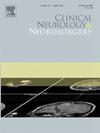The Impact of Functionality and Psychological Outcome on Social Engagement 3-months after Intracerebral Hemorrhage
IF 1.8
4区 医学
Q3 CLINICAL NEUROLOGY
引用次数: 0
Abstract
Background
Although it is well-known that intracerebral hemorrhage (ICH) is associated with physical and psychological morbidity, there is scant data on factors influencing social engagement after ICH. Understanding the relationship between functionality, psychological outcome and social engagement post-bleed may facilitate identification of patients at high risk for social isolation after ICH.
Methods
Patients ≥18-years-old with non-traumatic ICH from January 2015-March 2023 were identified from the Neurological Emergencies Outcomes at NYU (NEON) registry. Data on discharge functionality were collected from the medical record. 3-months post-bleed, patients/their legally-authorized representatives (LARs) were contacted to complete Neuro-QoL social engagement, anxiety, depression, and sleep inventories. Patients were stratified by ability to participate in social roles and activities (good=T-score>50, poor=T-score≤50) and satisfaction with social roles and activities (high=T-score>50 and low=T-score≤50). Univariate comparisons were performed to evaluate the relationship between post-bleed social engagement and both functionality and psychological outcome using Pearson’s chi-square, Fisher’s Exact test, and Mann-Whitney U tests. Multivariate logistic regression was subsequently performed using variables that were significant on univariate analysis (p<0.05).
Results
The social engagement inventories were completed for 55 patients with ICH; 29 (53 %) by the patient alone, 14 (25 %) by a LAR alone, and 12 (22 %) by both patient and LAR. 15 patients (27 %) had good ability to participate in social roles and activities and 10 patients (18 %) had high satisfaction with social roles and activities. Social engagement was associated with both functionality and psychological outcome on univariate analysis, but on multivariate analysis, it was only related to functionality; post-bleed ability to participate in social roles and activities was associated with discharge home, discharge GCS score, discharge mRS score, and discharge NIHSS score (p<0.05) and post-bleed satisfaction with social roles and activities was related to discharge mRS score and discharge NIHSS score (p<0.05).
Conclusion
In patients with nontraumatic ICH, social engagement post-bleed was related to discharge functionality, even when controlling for depression, anxiety, and sleep disturbance.
脑出血 3 个月后功能和心理结果对社会参与的影响
背景众所周知,脑内出血(ICH)与身体和心理疾病有关,但有关影响 ICH 后社会参与的因素的数据却很少。了解脑出血后功能、心理结果和社会参与之间的关系有助于识别ICH后社交孤立的高风险患者。方法从纽约大学神经急症结果(NEON)登记处确定了2015年1月至2023年3月期间年龄≥18岁的非创伤性ICH患者。从病历中收集了出院功能数据。出血后 3 个月,与患者/其法定授权代表(LAR)取得联系,让他们填写神经-生活质量(Neuro-QoL)社会参与、焦虑、抑郁和睡眠调查表。根据患者参与社会角色和活动的能力(好=T-score>50,差=T-score≤50)以及对社会角色和活动的满意度(高=T-score>50,低=T-score≤50)对患者进行分层。使用皮尔逊卡方检验、费雪精确检验和曼惠尼U检验进行单变量比较,以评估出血后社会参与与功能和心理结果之间的关系。结果 55 名 ICH 患者完成了社会参与问卷调查,其中 29 人(53%)由患者本人单独完成,14 人(25%)由 LAR 单独完成,12 人(22%)由患者和 LAR 共同完成。15名患者(27%)有很好的能力参与社会角色和活动,10名患者(18%)对社会角色和活动非常满意。在单变量分析中,社会参与与功能和心理结果都相关,但在多变量分析中,它只与功能相关;出血后参与社会角色和活动的能力与出院回家、出院 GCS 评分、出院 mRS 评分和出院 NIHSS 评分相关(p<0.结论在非创伤性 ICH 患者中,即使控制了抑郁、焦虑和睡眠障碍,出血后社会角色和活动的满意度与出院 mRS 评分和出院 NIHSS 评分相关(p<0.05)。
本文章由计算机程序翻译,如有差异,请以英文原文为准。
求助全文
约1分钟内获得全文
求助全文
来源期刊

Clinical Neurology and Neurosurgery
医学-临床神经学
CiteScore
3.70
自引率
5.30%
发文量
358
审稿时长
46 days
期刊介绍:
Clinical Neurology and Neurosurgery is devoted to publishing papers and reports on the clinical aspects of neurology and neurosurgery. It is an international forum for papers of high scientific standard that are of interest to Neurologists and Neurosurgeons world-wide.
 求助内容:
求助内容: 应助结果提醒方式:
应助结果提醒方式:


